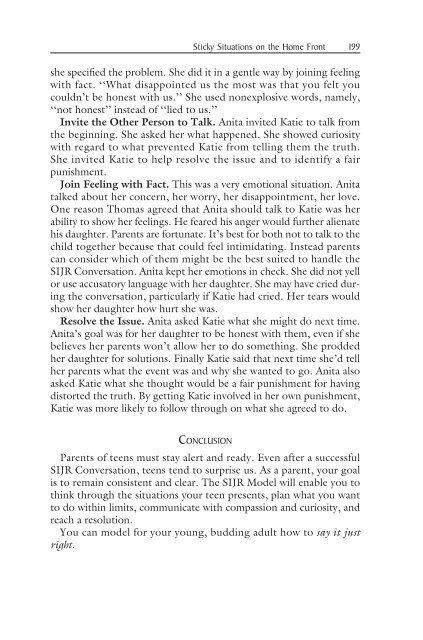Managing Sticky Situations at Work
Managing Sticky Situations at Work
Managing Sticky Situations at Work
Create successful ePaper yourself
Turn your PDF publications into a flip-book with our unique Google optimized e-Paper software.
<strong>Sticky</strong> <strong>Situ<strong>at</strong>ions</strong> on the Home Front 199she specified the problem. She did it in a gentle way by joining feelingwith fact. ‘‘Wh<strong>at</strong> disappointed us the most was th<strong>at</strong> you felt youcouldn’t be honest with us.’’ She used nonexplosive words, namely,‘‘not honest’’ instead of ‘‘lied to us.’’Invite the Other Person to Talk. Anita invited K<strong>at</strong>ie to talk fromthe beginning. She asked her wh<strong>at</strong> happened. She showed curiositywith regard to wh<strong>at</strong> prevented K<strong>at</strong>ie from telling them the truth.She invited K<strong>at</strong>ie to help resolve the issue and to identify a fairpunishment.Join Feeling with Fact. This was a very emotional situ<strong>at</strong>ion. Anit<strong>at</strong>alked about her concern, her worry, her disappointment, her love.One reason Thomas agreed th<strong>at</strong> Anita should talk to K<strong>at</strong>ie was herability to show her feelings. He feared his anger would further alien<strong>at</strong>ehis daughter. Parents are fortun<strong>at</strong>e. It’s best for both not to talk to thechild together because th<strong>at</strong> could feel intimid<strong>at</strong>ing. Instead parentscan consider which of them might be the best suited to handle theSIJR Convers<strong>at</strong>ion. Anita kept her emotions in check. She did not yellor use accus<strong>at</strong>ory language with her daughter. She may have cried duringthe convers<strong>at</strong>ion, particularly if K<strong>at</strong>ie had cried. Her tears wouldshow her daughter how hurt she was.Resolve the Issue. Anita asked K<strong>at</strong>ie wh<strong>at</strong> she might do next time.Anita’s goal was for her daughter to be honest with them, even if shebelieves her parents won’t allow her to do something. She proddedher daughter for solutions. Finally K<strong>at</strong>ie said th<strong>at</strong> next time she’d tellher parents wh<strong>at</strong> the event was and why she wanted to go. Anita alsoasked K<strong>at</strong>ie wh<strong>at</strong> she thought would be a fair punishment for havingdistorted the truth. By getting K<strong>at</strong>ie involved in her own punishment,K<strong>at</strong>ie was more likely to follow through on wh<strong>at</strong> she agreed to do.CONCLUSIONParents of teens must stay alert and ready. Even after a successfulSIJR Convers<strong>at</strong>ion, teens tend to surprise us. As a parent, your goalis to remain consistent and clear. The SIJR Model will enable you tothink through the situ<strong>at</strong>ions your teen presents, plan wh<strong>at</strong> you wantto do within limits, communic<strong>at</strong>e with compassion and curiosity, andreach a resolution.You can model for your young, budding adult how to say it justright.















